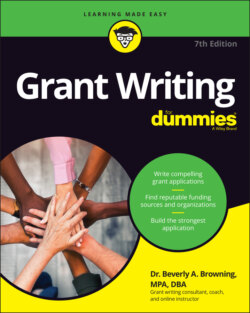Читать книгу Grant Writing For Dummies - Stan Hutton, Beverly A. Browning - Страница 68
Finding out where the money is in your state or territory
ОглавлениеTo find grant opportunities at the state level:
Visit your state government or territory website. If you search the state site and can’t find a listing of all the state’s grant opportunities, call the governor’s office and ask to be directed to the various agencies that give grants. Only track grantfunding opportunities from the agency that administers the federal programming for the type of funding that your organization is seeking. For example, a charter school will track state Department of Education grant alerts. A substance abuse prevention agency will track state Department of Health and/or Human Services grant alerts.
Email or call each appropriate state agency. Contact the agencies responsible for carrying out legislative funding mandates relevant to your own funding needs and be sure to get on their mailing lists for grantfunding opportunity alerts.
When you receive an alert about a state or territory grantfunding opportunity you’re interested in applying for, look for the link that connects you to the grant application summary and download the complete grant application (including guidelines). Look for the following information:
Type of application: Is it an electronic or a print application? For example, the majority of grant applications are submitted electronically via online e-grant portals; some state agencies can still only accept hard copies.
Due date: Make sure the due date is manageable and gives you enough time to collect topic-related information and write the application. A reasonable amount of time is 30 days from the date the grantfunding announcement is published or issued via email and the actual due date of the application.
Who’s eligible to apply: Every grant competition has a section listing the types of grant applicants eligible to apply for funds (Chapter 1 gives you a list of eligible grant applicants). If your organization’s forming structure (local education agency, nonprofit, and so forth) isn’t listed, consider partnering with an eligible applicant. (Head to Chapters 9, 10, and 11 for more on finding the right grantseeking partners.) You may also want to contact the funding agency to clarify any non-published eligible applicants because your organization may be eligible to apply after all.
The number of grants to be awarded: You may have to call the funding agency’s contact person to find out the number of available grants; this information often isn’t included in state grant application guidelines. Unless you’re the only organization delivering highly specialized services/programs and have no competitors, don’t apply for competitive grant funds where fewer than three awards will be made statewide. The fewer the number of grant awards, the worse the odds are for winning an award.
All grant applicants have a fair chance of winning a state or territory agency grant award if a sufficient number of awards are available. I always ask how many grants will be awarded so I know how many ways the money will be divided. This information helps me develop a more competitive project budget — staying conservative and on the low end of the average grant range. (Browse Chapter 18 for pointers on putting together a winning budget section in your grant or cooperative agreement proposal.)
